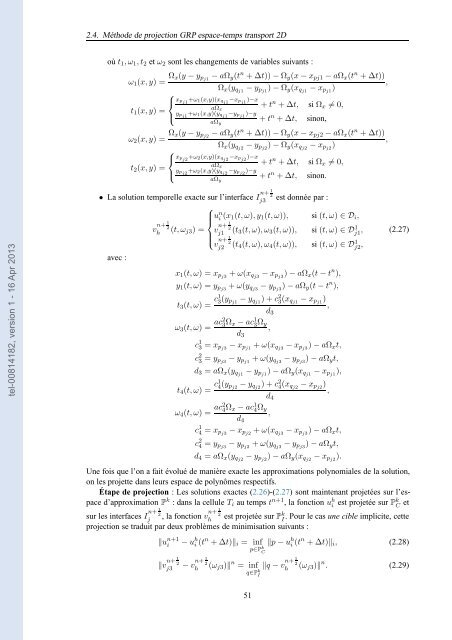Méthodes numériques pour des systèmes hyperboliques avec terme ...
Méthodes numériques pour des systèmes hyperboliques avec terme ...
Méthodes numériques pour des systèmes hyperboliques avec terme ...
You also want an ePaper? Increase the reach of your titles
YUMPU automatically turns print PDFs into web optimized ePapers that Google loves.
2.4. Méthode de projection GRP espace-temps transport 2D<br />
où t 1 ,ω 1 ,t 2 et ω 2 sont les changements de variables suivants :<br />
ω 1 (x,y) = Ω x(y −y pj1 −aΩ y (t n +∆t))−Ω y (x−x pj1 −aΩ x (t n +∆t))<br />
,<br />
Ω x (y qj1 −y pj1 )−Ω y (x qj1 −x pj1 )<br />
⎧<br />
⎨x pj1 +ω 1 (x,y)(x qj1 −x pj1 )−x<br />
aΩ<br />
t 1 (x,y) =<br />
x<br />
+t n +∆t, si Ω x ≠ 0,<br />
⎩<br />
+t n +∆t, sinon,<br />
y pj1 +ω 1 (x,y)(y qj1 −y pj1 )−y<br />
aΩ y<br />
ω 2 (x,y) = Ω x(y −y pj2 −aΩ y (t n +∆t))−Ω y (x−x pj2 −aΩ x (t n +∆t))<br />
,<br />
Ω x (y qj2 −y pj2 )−Ω y (x qj2 −x pj2 )<br />
⎧<br />
⎨x pj2 +ω 2 (x,y)(x qj2 −x pj2 )−x<br />
aΩ<br />
t 2 (x,y) =<br />
x<br />
+t n +∆t, si Ω x ≠ 0,<br />
⎩<br />
+t n +∆t, sinon.<br />
y pj2 +ω 2 (x,y)(y qj2 −y pj2 )−y<br />
aΩ y<br />
tel-00814182, version 1 - 16 Apr 2013<br />
• La solution temporelle exacte sur l’interface I n+1 2<br />
j3<br />
est donnée par :<br />
⎧<br />
u ⎪⎨<br />
n i (x 1(t,ω),y 1 (t,ω)), si (t,ω) ∈ D i ,<br />
v n+1 2<br />
h<br />
(t,ω j3 ) = v n+1 2<br />
j1<br />
(t 3 (t,ω),ω 3 (t,ω)), si (t,ω) ∈ Dj1 1<br />
⎪⎩<br />
, (2.27)<br />
v n+1 2<br />
j2<br />
(t 4 (t,ω),ω 4 (t,ω)), si (t,ω) ∈ Dj2 1 ,<br />
<strong>avec</strong> :<br />
x 1 (t,ω) = x pj3 +ω(x qj3 −x pj3 )−aΩ x (t−t n ),<br />
y 1 (t,ω) = y pj3 +ω(y qj3 −y pj3 )−aΩ y (t−t n ),<br />
t 3 (t,ω) = c1 3 (y p j1<br />
−y qj1 )+c 2 3 (x q j1<br />
−x pj1 )<br />
d 3<br />
,<br />
ω 3 (t,ω) = ac2 3 Ω x −ac 1 3 Ω y<br />
d 3<br />
,<br />
c 1 3 = x pj3 −x pj1 +ω(x qj3 −x pj3 )−aΩ x t,<br />
c 2 3 = y p j3<br />
−y pj1 +ω(y qj3 −y pj3 )−aΩ y t,<br />
d 3 = aΩ x (y qj1 −y pj1 )−aΩ y (x qj1 −x pj1 ),<br />
t 4 (t,ω) = c1 4 (y p j2<br />
−y qj2 )+c 2 4 (x q j2<br />
−x pj2 )<br />
d 4<br />
,<br />
ω 4 (t,ω) = ac2 4 Ω x −ac 1 4 Ω y<br />
d 4<br />
,<br />
c 1 4 = x p j3<br />
−x pj2 +ω(x qj3 −x pj3 )−aΩ x t,<br />
c 2 4 = y pj3 −y pj2 +ω(y qj3 −y pj3 )−aΩ y t,<br />
d 4 = aΩ x (y qj2 −y pj2 )−aΩ y (x qj2 −x pj2 ).<br />
Une fois que l’on a fait évolué de manière exacte les approximations polynomiales de la solution,<br />
on les projette dans leurs espace de polynômes respectifs.<br />
Étape de projection : Les solutions exactes (2.26)-(2.27) sont maintenant projetées sur l’espace<br />
d’approximation P k : dans la cellule T i au temps t n+1 , la fonction u h i est projetée sur Pk C et<br />
sur les interfaces I n+1 2<br />
j<br />
, la fonction v n+1 2<br />
h<br />
est projetée sur P k I<br />
. Pour le cas une cible implicite, cette<br />
projection se traduit par deux problèmes de minimisation suivants :<br />
‖u n+1<br />
i<br />
−u h i (tn +∆t)‖ i = inf ‖p−u h<br />
p∈P k i (tn +∆t)‖ i , (2.28)<br />
C<br />
‖v n+1 2<br />
j3<br />
−v n+1 2<br />
h<br />
(ω j3 )‖ n = inf ‖q −v n+1 2<br />
q∈P k h<br />
(ω j3 )‖ n . (2.29)<br />
I<br />
51
















